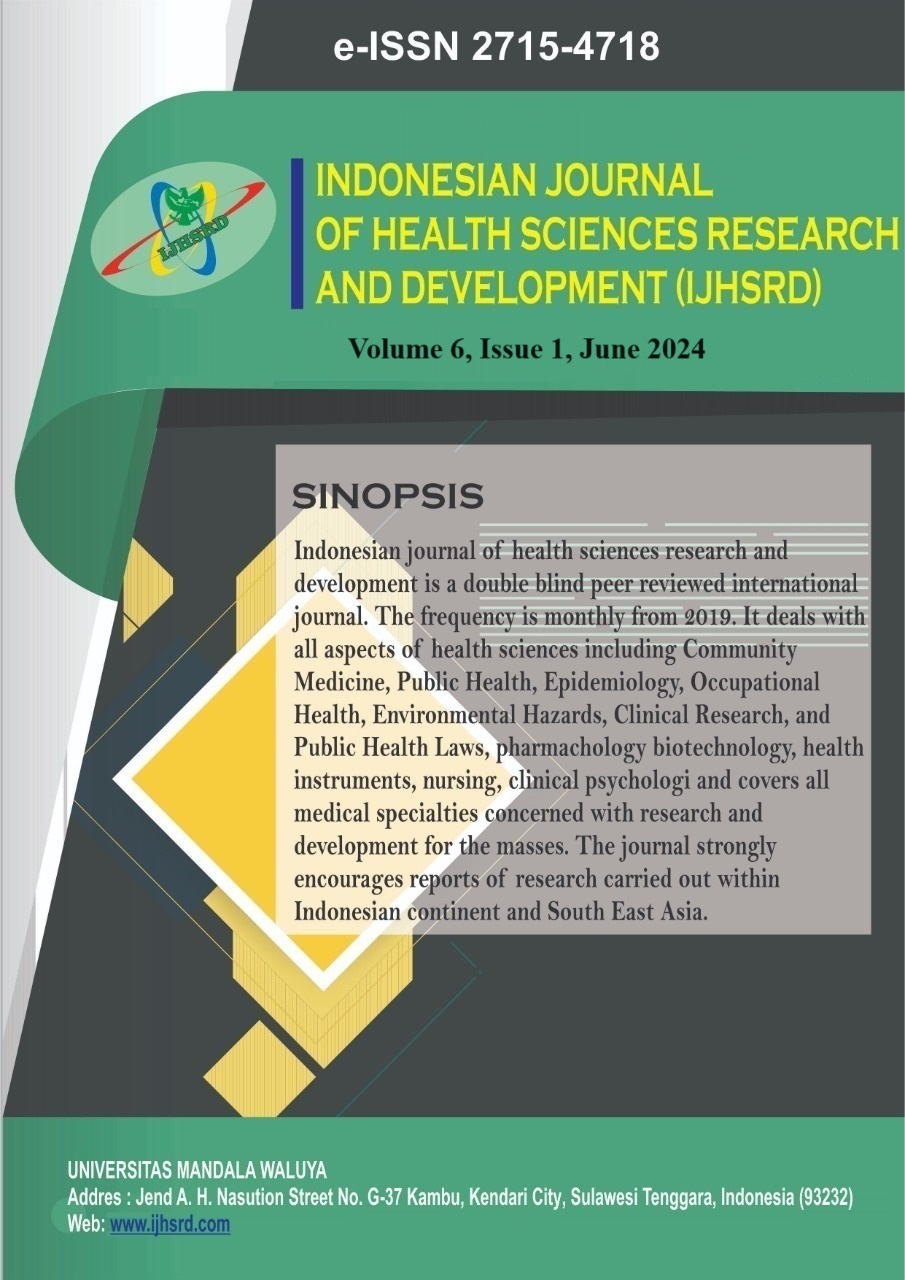Main Article Content
Abstract
Background: Therapeutic communication is communication designed, planned for therapeutic purposes in fostering relationships between nurses and patients so that they can adapt to stress, overcome psychological disorders experienced by patients, so that they can relieve and make patients feel very comfortable, which in turn accelerates the patient's healing process. starting from the pre-interaction stage, the work stage and the termination stage by providing accurate information to that they can assist patients in overcoming problems during the treatment stage. This study aims to describe the therapeutic communication of nurses at Santa Elisabeth Hospital Medan.
Methods: The research design used is a descriptive study with a cross-sectional approach with 7,772 population of inpatients. The instrument used is nurse therapeutic communication variable questionnaire sheet. The sampling technique is purposive sampling with a total sample of 94 respondents
Results: The study results found that the nurse's therapeutic communication at Santa Elisabeth Hospital Medan. The pre-interaction stage is in very good category 87%, the work stage is 90%, and the termination stage is in good category 65%.
Conclusions: Based on the results obtained, it can be concluded that nurse therapeutic communication is very well carried out by nurses when carrying out nursing actions and providing nursing care to patients, and remembering more about introducing their identity to clients, and remembering to make contracts for the next meeting. It is hoped that this research can be input for hospitals and nurses continue to provide good therapeutic communication to patients, for health institutions to reference material in therapeutic communication courses.
Keywords
Article Details

This work is licensed under a Creative Commons Attribution-ShareAlike 4.0 International License.
References
- Adjunct M. Komunikasi kesehatan berbasis terapeutik [Internet]. 1st ed. Indi Vidyafi, editor. Depok: PT.RajaGrafindo Persada; 2021. 1–18
- Rosdahl, C. B., & Kowalski MT. Textbook of Basic Nursing [Internet]. 10th ed. Wolters Kluwer, editor. New York: Lippincott Williams & Wilkins.; 2008.
- Alfianto, Ahmad Guntur Widiarta GB, Suharto A. Aplikasi Komunikasi Terapeutik dalam Keperawatan Berbasis Perilaku Caring [Internet]. Made Martini, editor. Media Sains Indonesia; 2023.
- Wulandari RA, Asmaningrum N, Ardiana A. Transcultural Communication Strategies in Nursing with Multicultural Clients in Hospital Settings: A Systematic Literature Review. J Pendidik Keperawatan Indones [Internet]. 2022 Dec 31;8(2):91–106. Available from: https://ejournal.upi.edu/index.php/JPKI/article/view/47326
- Akbar MI, Isrul M, Yati M, Kurniawan A, Hasni U, Putri A, La Olu S. Peningkatan Pengetahuan Pada Ibu Usia Produktif Mengenai Pencegahan Stunting Sejak Dini Menggunakan Media Slide dan Media Cetak di Desa Pamandati Kec. Lainea. Jurnal Mandala Pengabdian Masyarakat. 2023 Dec 31;4(2):330-4.
- Ariyanti S. Nurse’s Therapeutic Communication Affects Patient Satisfaction and Motivation Level. J Complement Nurs. 2022;1(3):91–
- Denise F. Polit CTB. Nursing Research: Principles and Methods. Seventh Ed. New York: Lippincott Williams & Wilkins; 2012.
- Akbar MI, Effendi DS, Dewi N, Lestari H, Kohali RE. Interconnection study of stunting events in North Buton District. InProceedings of the 2nd Alauddin Health and Medical International Conference 2024 Mar 28.
- Tasnim,T., Saputra, A. The effect of health promotion using booklet Media on the level of public knowledge about Sewerage waste water in coastal areas Samajaya village. Indonesian Journal of Health Sciences Research and Development (IJHSRD). 2022, 4(1), 26-33. Doi: https://doi.org/10.36566/ijhsrd/Vol4.Iss1/122.
- Tasnim,T., Rahmatia, S. The Health Promotion Strategy To Increase Covid-19 Vaccination Coverage In Lampeapi Health Center. Indonesian Journal of Health Sciences Research and Development. 2023, 5(1), 80-88. Doi: https://doi.org/10.36566/ijhsrd/Vol5.Iss1/152.
